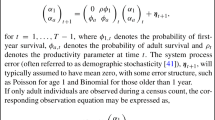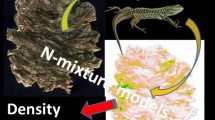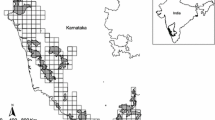Abstract
Integrated population models provide a framework for assimilating multiple datasets to understand population dynamics. Understanding drivers of demography is key to improving wildlife management, and integrated population models have informed conservation practices for many species of conservation concern. Motivated by multiple surveys of lesser prairie-chicken (Tympanuchus pallidicinctus), we developed a flexible integrated population modeling framework for assimilating demographic data with multiple surveys of abundance. Measurements of abundance are derived from aerial and ground surveys that vary in their observational uncertainty, sampling design, temporal coverage, and survey effort. Our proposed integrated population model draws from the strengths of each survey and prevents their sampling biases from compromising inference. We facilitate posterior inference for our integrated population model using chained Markov melding, which induces the joint distribution for all data sources by linking inference across several submodels. Using Markov melding, we extend the modeling framework previously proposed for analyzing the individual data sources while still obtaining joint Bayesian inference. We fit the melded model with a multistage Markov chain Monte Carlo algorithm that decreases run time and improves mixing. We assimilate data from several state and federal wildlife agencies and over a dozen independent researchers to infer lesser prairie-chicken abundance and vital rates across its entire range over the last 18 years. Supplementary materials accompanying this paper appear online.





Similar content being viewed by others
References
Abadi F, Gimenez O, Ullrich B, Arlettaz R, Schaub M (2010) Estimation of immigration rate using integrated population models. J Appl Ecol 47(2):393–400
Applegate RD (2000) Use and misuse of prairie chicken lek surveys. Wildl Soc Bull 457–459
Berigan LA, Aulicky CS, Teige EC, Sullins DS, Haukos DA, Fricke KA, Reitz JH, Rossi LG, Schultz KA, Ricketts AM (2022) Availability of lesser prairie-chicken nesting habitat impairs restoration success. Wildl Soc Bull 46(5):e1379
Besbeas P, Freeman SN, Morgan BJ, Catchpole E (2002) Integrating mark-recapture-recovery and census data to estimate animal abundance and demographic parameters. Biometrics 58(3):540–547
Butler MJ, Ballard WB, Holt RD, Whitlaw HA (2010) Sound intensity of booming in lesser prairie-chickens. J Wildl Manag 74(5):1160–1162
Caswell H (1978) A general formula for the sensitivity of population growth rate to changes in life history parameters. Theor Popul Biol 14(2):215–230
Cooch EG, White GC (2008) Program MARK, “A Gentle Introduction”
Cummings JW, Converse SJ, Moore CT, Smith DR, Nichols CT, Allan NL, O’Meilia CM (2017) A projection of lesser prairie chicken (Tympanuchus pallidicinctus) populations range-wide. Technical report, US Geological Survey
Dahlgren DK, Guttery MR, Messmer TA, Caudill D, Dwayne Elmore R, Chi R, Koons DN (2016) Evaluating vital rate contributions to greater sage-grouse population dynamics to inform conservation. Ecosphere 7(3):e01249
Davis AJ, Hooten MB, Phillips ML, Doherty PF Jr (2014) An integrated modeling approach to estimating Gunnison sage-grouse population dynamics: combining index and demographic data. Ecol Evol 4(22):4247–4257
Dawid AP, Lauritzen SL (1993) Hyper Markov laws in the statistical analysis of decomposable graphical models. Ann Stat 21(3):1272–1317
Diggle PJ, Menezes R, Su T-L (2010) Geostatistical inference under preferential sampling. J R Stat Soc Ser C (Appl Stat) 59(2):191–232
Dinsmore SJ, White GC, Knopf FL (2002) Advanced techniques for modeling avian nest survival. Ecology 83(12):3476–3488
Eddelbuettel D, François R (2011) Rcpp: seamless R and C++ integration. J Stat Softw 40:1–18
Eggeman DR, Johnson FA (1989) Variation in effort and methodology for the midwinter waterfowl inventory in the Atlantic Flyway. Wildl Soc Bull 17(3):227–233
Fletcher RJ, McCleery RA, Greene DU, Tye CA (2016) Integrated models that unite local and regional data reveal larger-scale environmental relationships and improve predictions of species distributions. Landscape Ecol 31:1369–1382
Fournier D, Archibald CP (1982) A general theory for analyzing catch at age data. Can J Fish Aquat Sci 39(8):1195–1207
Fritts SR, Grisham BA, Cox RD, Boal CW, Haukos DA, McDaniel P, Hagen CA, Greene DU (2018) Interactive effects of severe drought and grazing on the life history cycle of a bioindicator species. Ecol Evol 8(18):9550–9562
Frost F, McCrea R, King R, Gimenez O, Zipkin E (2023) Integrated population models: achieving their potential. J Stat Theory Pract 17(1):6
Gilpin M (2012) Metapopulation dynamics: empirical and theoretical investigations. Academic Press, Cambridge
Goudie RJ, Presanis AM, Lunn D, De Angelis D, Wernisch L (2019) Joining and splitting models with Markov melding. Bayesian Anal 14(1):81
Grace J, Anderson T, Seabloom E et al (2016) Integrative modelling reveals mechanisms linking productivity and plant species richness. Nature 529:390–393
Grisham BA, Boal CW (2015) Causes of mortality and temporal patterns in breeding season survival of lesser prairie-chickens in shinnery oak prairies. Wildl Soc Bull 39(3):536–542
Grisham BA, Boal CW, Haukos DA, Davis DM, Boydston KK, Dixon C, Heck WR (2013) The predicted influence of climate change on lesser prairie-chicken reproductive parameters. PLoS ONE 8(7):e68225
Grisham BA, Borsdorf PK, Boal CW, Boydston KK (2014) Nesting ecology and nest survival of lesser prairie-chickens on the Southern High Plains of Texas. J Wildl Manag 78(5):857–866
Grisham BA, Godar AJ, Boal CW, Haukos DA (2016) Interactive effects between nest microclimate and nest vegetation structure confirm microclimate thresholds for lesser prairie-chicken nest survival. Condor Ornithol Appl 118(4):728–746
Hagen CA, Garton EO, Beauprez G, Cooper BS, Fricke KA, Simpson B (2017) Lesser prairie-chicken population forecasts and extinction risks: an evaluation 5 years post-catastrophic drought. Wildl Soc Bull 41(4):624–638
Hagen CA, Jamison BE, Giesen KM, Riley TZ (2004) Guidelines for managing lesser prairie-chicken populations and their habitats. Wildl Soc Bull 32(1):69–82
Hagen CA, Pavlacky DC Jr, Adachi K, Hornsby FE, Rintz TJ, McDonald LL (2016) Multiscale occupancy modeling provides insights into range-wide conservation needs of lesser prairie-chicken (Tympanuchus pallidicinctus). Condor Ornithol Appl 118(3):597–612
Hagen CA, Pitman JC, Sandercock BK, Robel RJ, Applegate RD (2007) Age-specific survival and probable causes of mortality in female lesser prairie-chickens. J Wildl Manag 71(2):518–525
Hagen CA, Sandercock BK, Pitman JC, Robel RJ, Applegate RD (2009) Spatial variation in lesser prairie-chicken demography: a sensitivity analysis of population dynamics and management alternatives. J Wildl Manag 73(8):1325–1332
Harryman SW, Grisham BA, Boal CW, Kahl SS, Martin RL, Hagen CA (2019) Multiscale habitat selection of lesser prairie-chickens in a row-crop and conservation reserve program land matrix. J Fish Wildl Manage 10(1):126–136
Haukos DA, Boal C (2016) Ecology and conservation of lesser prairie-chickens. CRC Press, Boca Raton
Hooten MB, Hefley TJ (2019) Bringing Bayesian models to life. CRC Press, Boca Raton
Hooten MB, Johnson DS, Brost BM (2021) Making recursive Bayesian inference accessible. Am Stat 75(2):185–194
Isaac NJ, van Strien AJ, August TA, de Zeeuw MP, Roy DB (2014) Statistics for citizen science: extracting signals of change from noisy ecological data. Methods Ecol Evol 5(10):1052–1060
King R, Brooks SP, Mazzetta C, Freeman SN, Morgan BJ (2008) Identifying and diagnosing population declines: a Bayesian assessment of lapwings in the UK. J R Stat Soc Ser C (Appl Stat) 57(5):609–632
Kunkel A (2020) Breeding season survival of lesser prairie-chickens (Tympanuchus pallidicinctus) and fire ecology in the Shinnery Oak Prairie of eastern New Mexico. PhD thesis, New Mexico State University
Lautenbach JD, Haukos DA, Lautenbach JM, Hagen CA (2021) Ecological disturbance through patch-burn grazing influences lesser prairie-chicken space use. J Wildl Manag 85(8):1699–1710
Lautenbach JM (2015) Lesser prairie-chicken reproductive success, habitat selection, and response to trees. PhD thesis, Kansas State University
Lautenbach JM, Haukos DA, Sullins DS, Hagen CA, Lautenbach JD, Pitman JC, Plumb RT, Robinson SG, Kraft JD (2019) Factors influencing nesting ecology of lesser prairie-chickens. J Wildl Manag 83(1):205–215
Lawrence AJ, Boggie MA, Gould WR, Carleton SA, Nichols CT (2022) Differential seasonal avoidance of anthropogenic features and woody vegetation by Lesser Prairie-Chickens. Ornithol Appl 124(3):duac022
Lawrence AJ, Carleton SA, Gould WR, Nichols CT (2021) Lesser prairie-chicken survival in varying densities of energy development. J Wildl Manag 85(6):1256–1266
Leung B, Hargreaves AL, Greenberg DA, McGill B, Dornelas M, Freeman R (2020) Clustered versus catastrophic global vertebrate declines. Nature 588(7837):267–271
Link WA, Sauer JR (1999) Controlling for varying effort in count surveys: An analysis of Christmas Bird Count data. J Agric Biol Environ Stat 116–125
Loreau M, Cardinale BJ, Isbell F, Newbold T, O’Connor MI, de Mazancourt C (2022) Do not downplay biodiversity loss. Nature 601(7894):E27–E28
Lyons TP, Stodola KW, Benson TJ (2020) Estimating the survival of unmarked young from repeated counts. Wildl Biol 2020(1):1–9
Manderson AA, Goudie RJ (2022) Combining chains of Bayesian models with Markov melding. Bayesian Anal 1(1):1–34
Manderson and Goudie (2022) A numerically stable algorithm for integrating Bayesian models using Markov melding. Stat Comput 32(2):1–13
Maunder MN, Punt AE (2013) A review of integrated analysis in fisheries stock assessment. Fish Res 142:61–74
McCaslin HM, Feuka AB, Hooten MB (2021) Hierarchical computing for hierarchical models in ecology. Methods Ecol Evol 12(2):245–254
McDonald L, Beauprez G, Gardner G, Griswold J, Hagen C, Hornsby F, Klute D, Kyle S, Pitman J, Rintz T, Schoeling D, Van Pelt B (2014) Range-wide population size of the lesser prairie-chicken: 2012 and 2013. Wildl Soc Bull 38(3):536–546
McRoberts JT, Butler MJ, Ballard WB, Whitlaw HA, Haukos DA, Wallace MC (2011) Detectability of lesser prairie-chicken leks: a comparison of surveys from aircraft. J Wildl Manag 75(4):771–778
Miller DA, Pacifici K, Sanderlin JS, Reich BJ (2019) The recent past and promising future for data integration methods to estimate species’ distributions. Methods Ecol Evol 10(1):22–37
Millsap BA, Zimmerman GS, Kendall WL, Barnes JG, Braham MA, Bedrosian BE, Bell DA, Bloom PH, Crandall RH, Domenech R et al (2022) Age-specific survival rates, causes of death, and allowable take of golden eagles in the western United States. Ecol Appl 32(3):e2544
Nasman K, Rintz T, DiDonato G, Kulzer F (2022) Range-wide population size of the lesser prairie-chicken: 2012 to 2022. Technical report, Western EcoSystems Technology Inc, Laramie, Wyoming, USA
Olsen AC, Severson JP, Maestas JD, Naugle DE, Smith JT, Tack JD, Yates KH, Hagen CA (2021) Reversing tree expansion in sagebrush steppe yields population-level benefit for imperiled grouse. Ecosphere 12(6):e03551
Oyler-McCance SJ, DeYoung RW, Fike JA, Hagen CA, Johnson JA, Larsson LC, Patten MA (2016) Rangewide genetic analysis of lesser prairie-chicken reveals population structure, range expansion, and possible introgression. Conserv Genet 17:643–660
Pacifici K, Reich BJ, Miller DA, Gardner B, Stauffer G, Singh S, McKerrow A, Collazo JA (2017) Integrating multiple data sources in species distribution modeling: a framework for data fusion. Ecology 98(3):840–850
Parker NJ, Sullins DS, Haukos DA, Fricke KA, Hagen CA, Ahlers AA (2022) Demographic effects of a megafire on a declining prairie grouse in the mixed-grass prairie. Ecol Evol 12(12):e9544
Patten MA, Wolfe DH, Sherrod SK, Shochat E (2005) Effects of microhabitat and microclimate selection on adult survivorship of the lesser prairie-chicken. J Wildl Manag 69(3):1270–1278
Pitman JC, Hagen CA, Jamison BE, Robel RJ, Loughin TM, Applegate RD (2006) Nesting ecology of lesser prairie-chickens in sand sagebrush prairie of Southwestern Kansas. Wilson J Ornithol 118(1):23–35
Pollock KH, Winterstein SR, Bunck CM, Curtis PD (1989) Survival analysis in telemetry studies: the staggered entry design. J Wildl Manage 7–15
Robinson SG, Haukos DA, Plumb RT, Lautenbach JM, Sullins DS, Kraft JD, Lautenbach JD, Hagen CA, Pitman JC (2018) Nonbreeding home-range size and survival of lesser prairie-chickens. J Wildl Manag 82(2):413–423
Ross BE, Haukos DA, Hagen CA, Pitman J (2018) Combining multiple sources of data to inform conservation of lesser prairie-chicken populations. Auk Ornithol Adv 135(2):228–239
Royle JA (2004) N-mixture models for estimating population size from spatially replicated counts. Biometrics 60(1):108–115
Royle JA, Karanth KU, Gopalaswamy AM, Kumar NS (2009) Bayesian inference in camera trapping studies for a class of spatial capture-recapture models. Ecology 90(11):3233–3244
Royle JA, Kéry M (2007) A Bayesian state-space formulation of dynamic occupancy models. Ecology 88(7):1813–1823
Schaub M, Abadi F (2011) Integrated population models: a novel analysis framework for deeper insights into population dynamics. J Ornithol 152(1):227–237
Schaub M, Aebischer A, Gimenez O, Berger S, Arlettaz R (2010) Massive immigration balances high anthropogenic mortality in a stable eagle owl population: lessons for conservation. Biol Conserv 143(8):1911–1918
Schaub M, Jakober H, Stauber W (2013) Strong contribution of immigration to local population regulation: evidence from a migratory passerine. Ecology 94(8):1828–1838
Schaub M, Reichlin TS, Abadi F, Kéry M, Jenni L, Arlettaz R (2012) The demographic drivers of local population dynamics in two rare migratory birds. Oecologia 168:97–108
Steffen W, Broadgate W, Deutsch L, Gaffney O, Ludwig C (2015) The trajectory of the Anthropocene: the great acceleration. Anthropocene Rev 2(1):81–98
Steffen W, Crutzen PJ, McNeill JR et al (2007) The Anthropocene: are humans now overwhelming the great forces of nature. Ambio-J Hum Environ Res Manage 36(8):614–621
Stevens DL Jr, Olsen AR (2004) Spatially balanced sampling of natural resources. J Am Stat Assoc 99(465):262–278
Sullins DS, Kraft JD, Haukos DA, Robinson SG, Reitz JH, Plumb RT, Lautenbach JM, Lautenbach JD, Sandercock BK, Hagen CA (2018) Demographic consequences of conservation reserve program grasslands for lesser prairie-chickens. J Wildl Manag 82(8):1617–1632
Unger AM (2017) Playing chicken: At the intersection of anthropogenic development and lesser prairie-chickens. PhD thesis, Oklahoma State University
U.S. Fish and Wildlife Service (2023) Endangered and threatened wildlife and plants; lesser prairie-chicken; final rule
Van Ee JJ, Hagen CA Jr, Fricke KA, Koslovsky MD, Hooten MB (2023) Melding wildlife surveys to improve conservation inference. Biometrics 79(4):3941–3953
Van Pelt WE, Kyle S, Pitman J, Klute D, Beauprez G, Schoeling D, Janus A, Haufler J (2013) The lesser prairie-chicken range-wide conservation plan. Western Association of Fish and Wildlife Agencies, Cheyenne, Wyoming, USA, p 367
Weegman MD, Alisauskas RT, Kellett DK, Zhao Q, Wilson S, Telenskỳ T (2022) Local population collapse of Ross’s and lesser snow geese driven by failing recruitment and diminished philopatry. Oikos 2022(5):e09184
Weegman MD, Arnold TW, Clark RG, Schaub M (2021) Partial and complete dependency among data sets has minimal consequence on estimates from integrated population models. Ecol Appl 31(3):e2258
Weegman MD, Bearhop S, Fox AD, Hilton GM, Walsh AJ, McDonald JL, Hodgson DJ (2016) Integrated population modelling reveals a perceived source to be a cryptic sink. J Anim Ecol 85(2):467–475
White GC, Burnham KP (1999) Program MARK: survival estimation from populations of marked animals. Bird Study 46(sup1):S120–S139
Zipkin EF, Saunders SP (2018) Synthesizing multiple data types for biological conservation using integrated population models. Biol Conserv 217:240–250
Zipkin EF, Zylstra ER, Wright AD, Saunders SP, Finley AO, Dietze MC, Itter MS, Tingley MW (2021) Addressing data integration challenges to link ecological processes across scales. Front Ecol Environ 19(1):30–38
Acknowledgements
We thank C. Rewa and the USDA NRCS for support and funding. We thank landowners in Colorado, Kansas, Oklahoma, Texas, and New Mexico for allowing access on their properties to conduct the ground surveys and demographic surveys. We thank B. Cooper and Oklahoma Department of Wildlife Conservation (ODWC); J. Reitz, T. Verquer, J. Yost, and Colorado Parks and Wildlife (CPW); E. Teige, D. Peterson, and Kansas Department Wildlife and Parks (KDWP); Texas Parks and Wildlife Department (TPWD); Natural Heritage New Mexico and New Mexico Department of Game and Fish (NMDGF) for contributing the ground data. We thank S. Carleton, C. Strong, A. Meyers, Alex Kunkel, New Mexico State University, and the Nature Conservancy; S. Harryman and Texas Tech University; Jonathan Lautenbach, Joseph Lautenbach, N. Parker, S. Robinson and Kansas State University for providing demographic data. We thank an anonymous reviewer and editor for providing suggestions to improve the manuscript. We acknowledge the assistance of the WEST crew members and pilots. Any use of trade, firm, or product names is for descriptive purposes only and does not imply endorsement by the U.S. Government.
Funding
The aerial and ground surveys have been financed, in part, with Federal aide from the U.S. Fish and Wildlife Service, a division of the U.S. Department of Interior, and administered by KDWP, ODWC, TPWD, and NMDGF. The contents and opinions, however, do not necessarily reflect the views or policies of the U.S. Department of Interior or the five state wildlife agencies, but does represent the views of the U.S. Geological Survey. Funding for methodological aspects of this research was also provided by the National Science Foundation (NSF 2222525 and NSF 1927177 ).
Author information
Authors and Affiliations
Corresponding author
Ethics declarations
Conflict of interest
The authors have no relevant financial or non-financial interests to disclose.
Additional information
Publisher's Note
Springer Nature remains neutral with regard to jurisdictional claims in published maps and institutional affiliations.
Supplementary Information
Below is the link to the electronic supplementary material.
Supplementary information
The Web Supplements referenced in the manuscript as well as code for the MCMC algorithms and conducting the simulation study are available in the supplementary electronic files. (pdf 12.078KB)
Rights and permissions
Springer Nature or its licensor (e.g. a society or other partner) holds exclusive rights to this article under a publishing agreement with the author(s) or other rightsholder(s); author self-archiving of the accepted manuscript version of this article is solely governed by the terms of such publishing agreement and applicable law.
About this article
Cite this article
Van Ee, J.J., Hagen, C.A., Pavlacky, D.C. et al. Melded Integrated Population Models. JABES (2024). https://doi.org/10.1007/s13253-024-00620-2
Received:
Accepted:
Published:
DOI: https://doi.org/10.1007/s13253-024-00620-2




